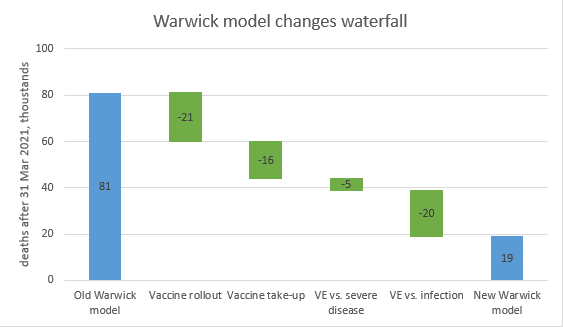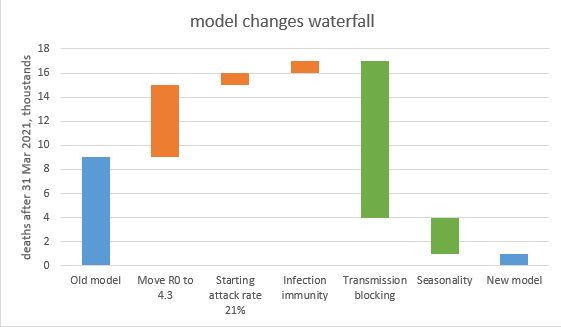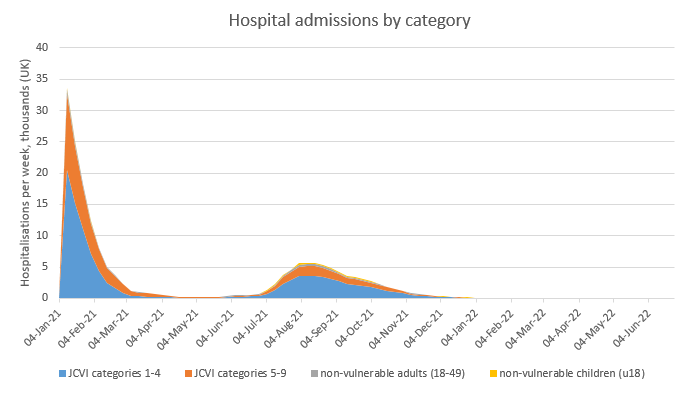
Having spent a good chunk of yesterday going through the recent SPI-M papers including the latest models from Warwick, Imperial and LSHTM, and then come back up for air, what have I learned? Here’s my summary of ten important messages: 1/14
1. While the headlines have once again been full of doom-laden reports of a huge ‘exit wave’ when we unlock in the summer, the reality is that both Warwick and Imperial models are now predicting a much smaller wave with only 15-20k deaths in their central scenarios. 2/14 

2. Looking at the Warwick model in more detail, the change from previous iterations is mostly due to improved (more optimistic – or in my view, realistic) assumptions for vaccine rollout, vaccine take-up, vaccine efficacy vs. severe disease, and efficacy vs. infection. 3/14 

[Note my comparison is to the Warwick paper thelancet.com/journals/lanin… not the previous SPI-M model. The intermediate steps are calculated using my model to mimic Warwick's, which is not a perfect replica, but seems to be very close (to within +-2k deaths at the endpoints)] 4/14
3. Comparing the Warwick model to mine, they’re now very much in the same ballpark (i.e. predicting a small exit wave, within NHS capacity). The remaining difference is explainable by two missing factors in the Warwick model: transmission reduction, and seasonality. 5/14 

4. The Imperial model does include seasonality, and has a slightly lower central case than Warwick (15k deaths, vs 19k). They have also run a sensitivity that includes a partial transmission reduction (down by 30% after 2 doses of vaccine) – this reduces deaths to only 9k. 6/14 

5. I haven’t focused so much on the LSHTM model, as they themselves note that their work is “…preliminary and makes pessimistic assumptions about the impact of [the final stage of unlocking] which require further work to refine”. 7/14
6. The Warwick team do a separate analysis on seasonality, which shows how it may neatly squash our summer exit wave, and buy us time to complete the vaccination programme (including 2nd doses), so that the expected rebound in the winter never happens, or is very small. 8/14 

7. Both Warwick and Imperial also provide some insight from the regional structure of their models. This implies that while London and the Midlands might have very small exit waves, these could be much larger in the NE & Yorkshire, and in the South West. 9/14 

8. Both models stress the importance of baseline controls such as TTI, masks etc. for reducing transmission after unlocking in June. As my model is more optimistic, it makes a weaker case for retaining them – but I expect the govt will do so, to limit downside risks. 10/14
9. There is still a lot of uncertainty in all of the models – including mine – and a small change in assumptions can produce a large change in outcomes. Hence the need for caution and for watching the data closely. Variants remain the biggest unmodelled risk factor. 11/14
10. Overall, there’s a lot of impressive work in these papers. I know we all love to dump on the modellers, and I’ve had my own criticisms of them in the past, but they’re doing a difficult job, and these latest models have addressed a lot of issues I raised previously. 12/14
To conclude, I’ve attached a more detailed review and commentary on the model assumptions, comparing mine to those of Warwick and Imperial – for those who like that kind of thing. We’re a lot closer than before, but there’s still a few important differences. 13/14 

And finally here’s the page with links to all the papers, if you want to read more: gov.uk/government/pub… /end
@RDann15 this one (above) is for you - it's worth reading the detail in the Warwick paper (p22) if you haven't seen already
• • •
Missing some Tweet in this thread? You can try to
force a refresh
















